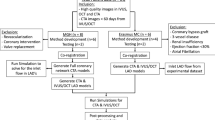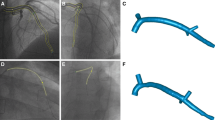Abstract
Computational fluid dynamics (CFD) methods based on three-dimensional (3D) vessel reconstructions have recently been shown to provide prognostically relevant hemodynamic data. However, the geometry reconstruction and the assessment of clinically relevant hemodynamic parameters may depend on the used imaging modality. In this study, the silicon model of the left coronary artery (LCA) was acquired with a biplane angiography. The geometry reconstruction was done using commercial CAAS 5.2 QCA 3D software and compared with an original geometry. The original model is an optically digitized post-mortem vessel cast. The biplane angiography reconstruction achieved a Hausdorff surface distance of 0.236 mm to the original geometry that is comparable with results obtained in our earlier study for computed tomography (CT) and magnetic resonance imaging (MRI) reconstructions. Steady flow simulations were performed with a commercial CFD program FLUENT. A comparison of the calculated wall shear stress (WSS) shows good correlation for histograms (r = 0.97) and good agreement among the four modalities with a mean WSS of 0.65 Pa in the original model, of 0.68 Pa in the CT-based model, of 0.67 Pa in the MRI based model, and of 0.69 Pa in the biplane angiography-based model. We can conclude that the biplane angiography-based reconstructions can be used for the WSS profiling of the coronary arteries.






Similar content being viewed by others
References
Affeld K., L. Goubergrits, J. Fernandez-Britto, and L. Falkon. Variability of the Geometry of the Human Common Carotid Artery, a Vessel Cast Study of 31 Specimens, Path. Res. Pr. 194:597-602, 1998.
Ali, M. H. and P. T. Schumacker. Endothelial responses to mechanical stress: Where is the mechanosensor? Crit Care Med 30:S198 –S206, 2002. doi:10.1097/00003246-200205001-00005
Aquaro G. D., G. Di Bella, E. Strata, M. Deiana, D. De Marchi, A. Pingitore, and M. Lombardi. Cardiac magnetic resonance findings in isolated congenital left ventricular diverticuli. Int J Cardiovasc Imaging 23:43–47, 2007. doi:10.1007/s10554-006-9120-9
Berthier B., R. Bouzerar, and C. Legallais. Blood flow patterns in an anatomically realistic coronary vessel: influence of three different reconstruction methods. Journal of Biomechanics 35:1347–1356, 2002. doi:10.1016/S0021-9290(02)00179-3
Birchall D., A. Zaman, J. Hacker, G. Davies, and D. Mendelow. Analysis of haemodynamic disturbance in the atherosclerotic carotid artery using computational fluid dynamics. Europ. Radiology 16:1074–1083, 2006. doi:10.1007/s00330-005-0048-6
Bom, N., C. L. de Korte, J. J. Wentzel, R. Krams, S. G. Carlier, A. W. van der Steen, C. J. Slager, and J. R. Roelandt. Quantification of plaque volume, shear stress on the endothelium, and mechanical properties of the arterial wall with intravascular ultrasound imaging. Z. Kardiol. 89(Suppl 2):105-111, 2000. doi:10.1007/s003920070108
Buchanan J. R., C. Kleinstreuer, G. A. Truskey, and M. Lei. Relation between non-uniform hemodynamics and sites of altered permeability and lesion growth at the rabbit aorto-celiac junction. Atherosclerosis 143:27–40, 1999. doi:10.1016/S0021-9150(98)00264-0
Cademartiri F., A. A. Palumbo, E. Maffei. Non invasive imaging of coronary arteries with 64-slice CT and 1.5T MRI: challenging invasive techniques. Acta Biomed 78:6–15, 2007.
Cirino, G., S. Fiorucci, and W.C. Sessa. Endothelial nitric oxide synthase: the Cinderella of inflammation? Trends in Pharmacological Sciences 24(2):91–95, 2003. doi:10.1016/S0165-6147(02)00049-4
Coles D. R., P. Wilde, M. Oberhoff, Ch. A. Rogers, K. R. Karsch, and A. Baumbach. Multislice computed tomography coronary angiography in patients admitted with a suspected acute coronary syndrome. Int J Cardiovasc Imaging 23:603–614, 2007. doi:10.1007/s10554-006-9193-5
De Feyter P. J., W. B. Meijboom, and A. Weustink. Spiral multislice computed tomography coronary angiography: a current status report. Clin. Cardiol. 30:437–42, 2007. doi:10.1002/clc.16
Frangos, S. G. Localization of atherosclerosis: role of hemodynamics. Arch. Surg. 134:1142-1149, 1999. doi:10.1001/archsurg.134.10.1142
Glor F. P., B. Ariff, A. D. Hughes, L. A. Crowe, P. R. Verdonck, D. C. Barratt, S. A. McG Thom, D. N. Firmin, and X. Y. Xu. Image-based carotid flow reconstruction: a comparison between MRI and ultrasound. Physiol. Meas. 25:1495–1509, 2004. doi:10.1088/0967-3334/25/6/014
Glor F. P., Q. Long, A. D. Hughes, A. D. Augst, B. Ariff, S. A. McG Thom, P. R. Verdonck, and X. Y. Xu. Reproducibility Study of Magnetic Resonance Image-Based Computational Fluid Dynamics Prediction of Carotid Bifurcation Flow. Annals of Biomedical Engineering 31:142–151, 2003. doi:10.1114/1.1537694
Goubergrits, L., K. Affeld, E. Wellnhofer, R. Zurbrugg, and T. Holmer. Estimation of wall shear stress in bypass grafts with computational fluid dynamics method. Int. J. Artif. Organs 24:145-151, 2001.
Goubergrits L., U. Kertzscher, B. Schöneberg, E. Wellnhofer, Ch. Petz, and H.-Ch. Hege. CFD Analysis in an Anatomically Realistic Coronary Artery Model Based on Non-invasive 3D Imaging: Comparison of Magnetic Resonance Imaging with Computed Tomography. International Journal of Cardiovascular Imaging 24(4):411-421, 2008. doi:10.1007/s10554-007-9275-z
He X. J., and D. N. Ku. Pulsatile flow in the human left coronary artery bifurcation: Average conditions. J. Biomech. Eng. - Trans. ASME 118:74–82, 1996. doi:10.1115/1.2837095
Kleinstreuer C., S. Hyun, J. R. Buchanan, P. W. Longest, J. P. Archie, and G. A. Truskey. Hemodynamic parameters and early intimal thickening in branching blood vessels. Crit. Rev. Biomed. Eng. 29:1–64, 2001.
Krams, R., J. J. Wentzel, J. A. Oomen, R. Vinke, J. C. Schuurbiers, P. J. de Feyter, P. W. Serruys, and C. J. Slager. Evaluation of endothelial shear stress and 3D geometry as factors determining the development of atherosclerosis and remodeling in human coronary arteries in vivo. Combining 3D reconstruction from angiography and IVUS with computational fluid dynamics. Arterioscler. Thromb. Vasc. Biol. 17:2061-2065, 1997.
LaDisa J. F., L. E. Olsona, I. Gulere, D. A. Hettricka, J. R. Kerstenb, D. C. Warltiera, and P. S. Pagela. Circumferential vascular deformation after stent implantation alters wall shear stress evaluated with time-dependent 3D computational fluid dynamics models. J Appl Physiol 98(3):947–957, 2005. doi:10.1152/japplphysiol.00872.2004
Lei M., C. Kleinstreuer, and G. A. Truskex. A focal stress gradient-dependent mass transfer mechanism for atherogenesis in branching arteries. Med. Eng. Phys. 18 (4):326-332, 1996. doi:10.1016/1350-4533(95)00045-3
Longest, P. W. Computational Analyses of Transient Particle Hemodynamics with Applications to Femoral Bypass Graft Designs. PhD thesis, North Carolina State University, Raleigh, 2002.
Lorensen, W. E., and H. E. Cline: Marching Cubes: A high resolution 3D surface construction algorithm. In: Computer Graphics 21(4):163-169, 1987. doi:10.1145/37402.37422
Malek A. M., S. L. Alper, and S. Izumo. Hemodynamic shear stress and its role in atherosclerosis J. Am.Med. Assoc. 282:2035–42, 1999. doi:10.1001/jama.282.21.2035
Myers J. G., J. A. Moore, M. Ojha, K.W. Johnston, and C.R. Ethier. Factors influencing blood flow patterns in the human right coronary artery. Annals of Biomedical Engineering 29:109–120, 2001. doi:10.1114/1.1349703
Nijenhuis R. J., M. J. Jacobs, K. Jaspers, M. Reijnders, J. M. A. van Engelshoven, T. Leiner, and W. H. Backes. Comparison of magnetic resonance with computed tomography angiography for preoperative localization of the Adamkiewicz artery in thoracoabdominal aortic aneurysm patients. Journal of Vascular Surgery 45:677–85, 2007. doi:10.1016/j.jvs.2006.11.046
Perktold K., M. Hofer, G. Rappitsch, M. Loew, B. D. Kuban, and M.H. Friedman. Validated computation of physiologic flow in a realistic coronary artery branch. J. Biomech. 31:217–228, 1998. doi:10.1016/S0021-9290(97)00118-8
Prakash S., and C. R. Ethier. Requirements for mesh resolution in 3-D computational hemodynamics. Journal of Biomedical Engineering 123:26–38, 2001.
Ramcharitar S., J. Daeman, M. Patterson, R. J. van Guens, E. Boersma, P. W. Serruys, W. J. van der Giessen. First direct in vivo comparison of two commercially available three-dimensional quantitative coronary angiography systems. Catheterization and Cardiovascular Interventions 71:44–50, 2008. doi:10.1002/ccd.21418
Resnick, N., S. Einav, L. Chen-Konak, M. Zilberman, H. Yahav, and A. Shay-Salit. Hemodynamic forces as stimulus for arteriogenesis. Endothelium 10(4-5):197-206, 2003. doi:10.1080/713715231
Stone P. H., A. U. Coskun, Y. Yeghiazarians, S. Kinlay, J. J. Popma, R. E. Kuntz, and C. L. Feldman. Prediction of sites of coronary atherosclerosis progression: In vivo profiling of endothelial shear stress, lumen, and outer vessel wall characteristics to predict vascular behavior. Curr. Opin. Cardiol. 18:458-470, 2003. doi:10.1097/00001573-200311000-00007
Munkres, J. Topology, 2nd ed. NJ: Prentice Hall, 1999.
Wellnhofer E., W. Bocksch, N. Hiemann, M. Dandel, W. Klimek, R. Hetzer, and E. Fleck. Shear stress and vascular remodeling: study of cardiac allograft coronary artery disease as a model of diffuse atherosclerosis. J Heart Lung Transplant. 21(4):405–416, 2002. doi:10.1016/S1053-2498(01)00374-6
Wellnhofer E., L. Goubergrits, U. Kertzscher, and K. Affeld. In-vivo coronary flow profiling based on biplane angiograms: influence of geometric simplifications on the three-dimensional reconstruction and wall shear stress calculation. Biomed Eng Online 5(1):39, 2006. doi:10.1186/1475-925X-5-39
Wellnhofer, E., L. Goubergrits, U. Kertzscher, K. Affeld, and E. Fleck. Novel non-dimensional approach to comparison of wall shear stress distributions in coronary arteries of different groups of patients. Atherosclerosis 202(2):483–490, 2009.
Acknowledgments
This study was supported by German Research Foundation (DFG). We thank Dr. Jose Fernandez-Britto, Pathology Department of the Dr. Finlay Hospital, Havana, Cuba, who fabricated the cast of the left coronary artery. We also thank Mr. Lothar Paul, 3D Data Processing Department of the GFaI, Berlin, Germany, who performed surface reconstructions and optical digitalization of the vessel cast.
Author information
Authors and Affiliations
Corresponding author
Rights and permissions
About this article
Cite this article
Goubergrits, L., Wellnhofer, E., Kertzscher, U. et al. Coronary Artery WSS Profiling Using a Geometry Reconstruction Based on Biplane Angiography. Ann Biomed Eng 37, 682–691 (2009). https://doi.org/10.1007/s10439-009-9656-7
Received:
Accepted:
Published:
Issue Date:
DOI: https://doi.org/10.1007/s10439-009-9656-7




